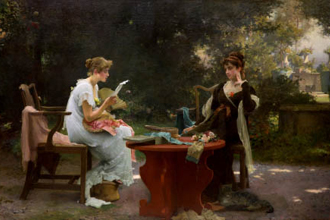Money as muse: artists in the marketplace
An interdisciplinary collaboration between two scholars at Tulane has led to pioneering insights into the world of art. The Development of the Art Market in England, co-authored by Thomas Bayer, an adjunct lecturer of art history, and John Page, an associate professor of accounting, reveals how market pressures shaped the visual culture of the time.

In England, market influences demanded that a lady be included in artwork, such as this painting by Marcus Stone, entitled “The First Love Letter” (1889). (Photo from Thomas Bayer and John Page)
“We approached it from several sides from the traditional art-historical approach, as well as using sophisticated tools for data analysis,” Bayer says. Their published research also is hybrid, with the printed book complemented by images on a website.
The study was prompted by Bayer's discovery of records of 42,000 art sales at British auction houses from 1730-1900. “This was particularly rich data,” says Bayer, “It includes variables that modern auction houses don't list, such as the names of buyers and sellers in addition to titles and prices.”
Page, who teaches a course in data analysis, provided the analytical expertise to track trends and patterns in this market over time. The research shows that artists made strategic decisions on what to paint, heeding advice from art dealers.
Bayer says, “Artists positioned themselves in the market by creating specific images, even to the extent of creating new movements. The key is to be different from your competitor, and they were aware of this.”
“The most common word in the 42,000 titles is 'lady,'” says Page.
“The demand was that a lady should be included,” observes Bayer. “Aspects of the market became apparent because we were the first to do this kind of analysis.”
A diverse audience is reading and responding to the study, according to the authors. “Writers like it,” says Bayer, “and artists find it useful to give them a sense of what they are as economic creatures.”
Development of the website was supported by a grant from the Provost's Fund for Faculty/Student Scholarly Engagement.
